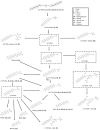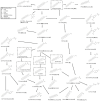PFAS Biotransformation Pathways: A Species Comparison Study
- PMID: 36668800
- PMCID: PMC9862377
- DOI: 10.3390/toxics11010074
PFAS Biotransformation Pathways: A Species Comparison Study
Abstract
Limited availability of fish metabolic pathways for PFAS may lead to risk assessments with inherent uncertainties based only upon the parent chemical or the assumption that the biodegradation or mammalian metabolism map data will serve as an adequate surrogate. A rapid and transparent process, utilizing a recently created database of systematically collected information for fish, mammals, poultry, plant, earthworm, sediment, sludge, bacteria, and fungus using data evaluation tools in the previously described metabolism pathway software system MetaPath, is presented. The fish metabolism maps for 10 PFAS, heptadecafluorooctyl(tridecafluorohexyl)phosphinic acid (C6/C8 PFPiA), bis(perfluorooctyl)phosphinic acid (C8/C8 PFPiA), 2-[(6-chloro-1,1,2,2,3,3,4,4,5,5,6,6-dodecafluorohexyl)oxy]-1,1,2,2-tetrafluoroethanesulfonic acid (6:2 Cl-PFESA), N-Ethylperfluorooctane-1-sulfonamide (Sulfuramid; N-EtFOSA), N-Ethyl Perfluorooctane Sulfonamido Ethanol phosphate diester (SAmPAP), Perfluorooctanesulfonamide (FOSA), 8:2 Fluorotelomer phosphate diester (8:2 diPAP), 8:2 fluorotelomer alcohol (8:2 FTOH), 10:2 fluorotelomer alcohol (10:2 FTOH), and 6:2 fluorotelomer sulfonamide alkylbetaine (6:2 FTAB), were compared across multiple species and systems. The approach demonstrates how comparisons of metabolic maps across species are aided by considering the sample matrix in which metabolites were quantified for each species, differences in analytical methods used to identify metabolites in each study, and the relative amounts of metabolites quantified. Overall, the pathways appear to be well conserved across species and systems. For PFAS lacking a fish metabolism study, a composite map consisting of all available maps would serve as the best basis for metabolite prediction. This emphasizes the importance and utility of collating metabolism into a searchable database such as that created in this effort.
Keywords: MetaPath; PFAS; biodegradation; biotransformation; comparison; fish; metabolism; pathway.
Conflict of interest statement
All studies reported in this manuscript were supported by the EPA, Office of Research and Development. The authors report no declaration of interest.
Figures



















References
-
- Smart B.E. Characteristics of C-F systems. In: Banks R.E., Smart B.E., Tatlow J.C., editors. Organofluorine Chemistry: Principles and Commercial Applications. Plenum; New York, NY, USA: 1994. pp. 57–88.
-
- Kissa E. Fluorinated Surfactants: Synthesis–Properties–Applications (Surfactant Science Series 50) Marcel Dekker; New York, NY, USA: 1994. 469p
-
- Kissa E. Fluorinated Surfactants and Repellents (2nd Edition Revised and Expanded) (Surfactant Science Series 97) Marcel Dekker; New York, NY, USA: 2001. 640p
-
- Rao N.S., Baker B.E. Textile finishes and fluorosurfactants. In: Banks R.E., Smart B.E., Tatlow J.C., editors. Organofluorine Chemistry: Principles and Commercial Applications. Plenum; New York, NY, USA: 1994. pp. 321–338.
-
- 3M Company Fluorochemical Use, Distribution and Release Overview. USEPAAdministrative Record AR226-0550. [(accessed on 6 January 2023)];1999 Available online: https://www.regulations.gov/document/EPA-HQ-OPPT-2002-0051-0003.
LinkOut - more resources
Full Text Sources
Miscellaneous

